OGSM
I was invited recently to a virtual meeting to lead a discussion on the alignment of business with IT. That segment generated a lot of questions, more than I could answer in the allocated time. What is OGSM? How does it work? How to implement it? These are some of the questions that will be the focus of this post.
What is OGSM?
My first exposure to OGSM was during strategy courses in graduate school and later in an advisory capacity to Fortune 500 organisations.
OGSM is a Strategy Framework (Figure 1) that helps CIOs identify business desired outcomes by identifying Objectives and Goals, then demonstrating to the business how these can be achieved through technology with defined strategic initiatives and measures.
Figure 1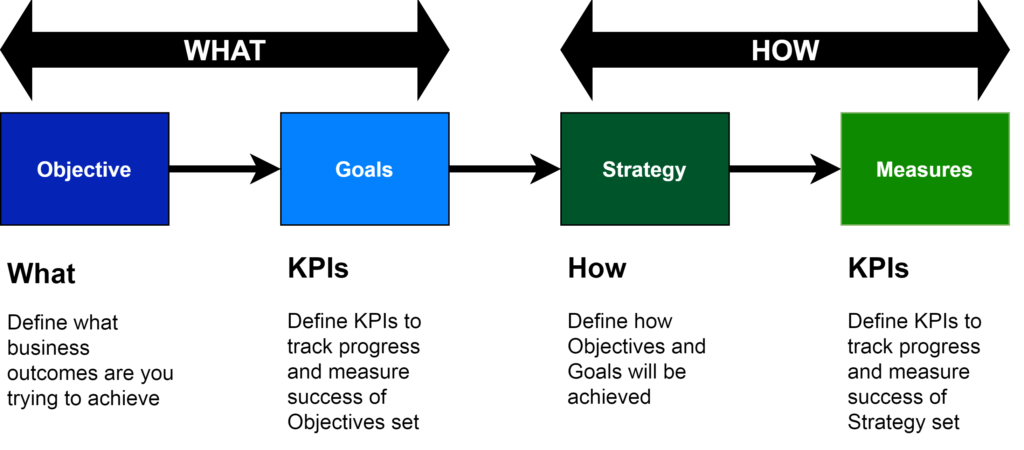
Enterprises will often have a corporate strategy set by the CEO or the board (Figure 2). Each business division will plan its strategy that is aligned with the overall corporate objective. IT leadership is to identify what the distinct business divisions are trying to achieve, then articulate how the technology can help them achieve it.
Figure 2
An example based on real client engagement; I will use to illustrate how OGSM works.
An enterprise organisation had a new CEO join. The CEO’s top priority objective was to double the revenue over the next 5 years.
The CIO agreed that OGSM framework is to be used to align the business with IT to help new CEO achieve corporate key objectives. This meant helping different business divisions develop their OGSM, which in turn will help the CIO plan his OGSM. Based on IT’s OGSM, technology initiatives will be prioritised to surgically map to business objectives. My responsibility was to work with the different divisional heads to help them build their OGSM.
In our example, the head of sales was one of the executive stakeholders I have worked with. The purpose of engagement with sales was to understand their key objectives and challenges. The information gathered will help the CIO articulate to sales how technology can address their business needs.
OGSM
Objective
The head of sales top objective was to meet the CEO’s primary objective, which is to double the revenue in 5 years. This constituted the “what” the division was aiming to achieve.
Goal
The Goal part of OGSM provides the scope of the business change needed so CIO can in turn map technology type and scope contribution effort. The goal needs to be measurable to track progress. The head of sales key goal was to increase sales by 15% annually over the next five years. The metrics here are the 15% annual growth rate over a five-year duration.
Strategy
Strategy in OGSM defines how Objectives and Goals will be achieved. In our example, the 15% growth over 5 years goal was going to be achieved using three strategies:
- Expand into new markets. The organization was going to expand into new markets in China and India.
- Increase sales efficiency. This will be achieved by automating time-consuming core sales and improve sales competency through training.
- Use Artificial Intelligence (AI) and Machine Learning (ML) to increase sales and optimize costs.
Measures
Measures are the metrics for strategy just as goals are the metrics for the objective. It is a metric the measures the success of a strategy. For example, automate sales core processes within 12 months is the measure.
Challenges
Only 30% of Salesforce achieved their quota. There were a few reasons that contribute to poor performance:
Challenge: The sales team spent over 70% of their time on administrative tasks.
Solution: Automate administrative tasks to free sales team to focus on sales.
Challenge: Majority of the sales team lacked in-depth industry knowledge and advanced sales skills. Given sales were geographically dispersed and getting everyone on-site for regular training was not workable or economical.
Solution: Develop an online/remote training capability.
Challenge: Sales lacked the expertise to optimize pricing for every deal. The reason is pricing complex product portfolio is a challenge. There is the added complexity caused by competition, volatile politics, and fluctuating cost of raw material.
Solution: Utilise AI to recommend optimal pricing based on historic and real-time data.
Challenge: Sales have a low closing ration compared to industry leaders. A key reason is wasted time by sales working on poor leads.
Solution: Use AI/ML to predict which leads are likely to progress and become won deals, based on historic data of deals won and lost.
Challenge: Upselling and cross-selling to existing customers have not been very successful due to focus on new business.
Solution: Use Machine Learning (ML) to analyse the existing customer database and identify new business opportunities.
Challenge: Customers leave a massive trail behind of information through their links clicked, searches, chat, e-mails, and a history of purchase decisions. Lack of relevant skills prevents the organisation from gaining valuable insights from all the data collected.
Solution: Machine Learning will recommend relevant sales/marketing content likely to trigger customer engagement.
How did the story conclude?
After 2 years, of implementing OGSM, the organisation is averaging 18% sales growth and is aggressively adopting cloud-based advanced AI/ML capabilities to augment its salesforce.
The organisation is no longer approving any technology initiatives without a “clear line of sight”
Figure 3
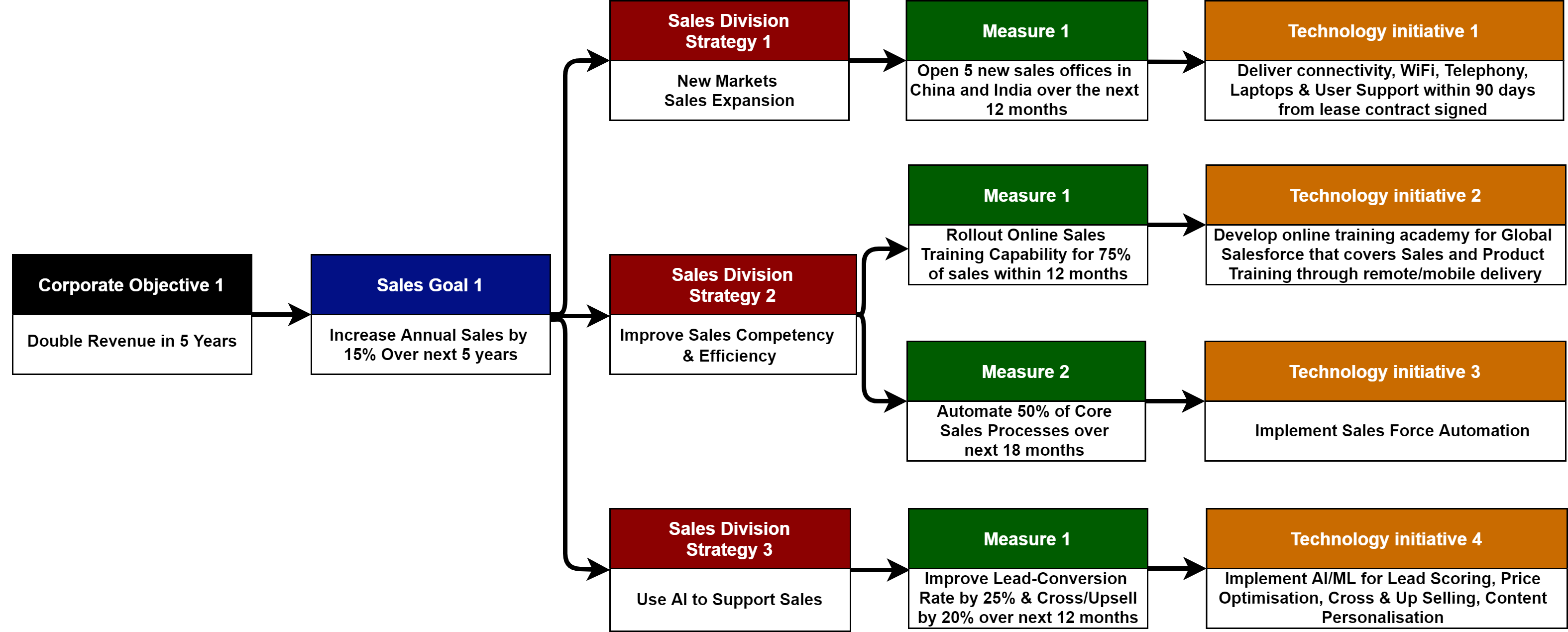
The above OGSM diagram (Figure3) helped the CIO provide the CEO and the board a powerful visual that many call “Clear Line of Sight” between strategy corporate objectives and technology initiatives.
 Do you have a Clear Line of Sight?
Do you have a Clear Line of Sight?
Now imagine as a CIO, instead of discussing metrics that cannot articulate the value of IT such as the number of servers patched, uptime, but instead can discuss how you contributed to sales achieving over 15% increase in sales through strategic technology initiatives.
COVID-19 and OGSM
The most important question asked, how can OGSM help with the chaos caused by Covid-19?
Many organisations have been forced to change their business model to adapt to the new normal. They are looking for ways to preserve cash, pursue new revenue opportunities and mitigate against new risks. Covid-19 is changing business priorities which demands alignment of the IT strategy with the ‘new normal’. This means reprioritising and recalibrating the entire projects portfolio to help not only survive Covid-19 challenge today but to thrive and prosper tomorrow. OGSM is the perfect tool to help with the strategic realignment.
I hope you have found this post informative and thank you for reading.
Thank you and be safe.
Nick
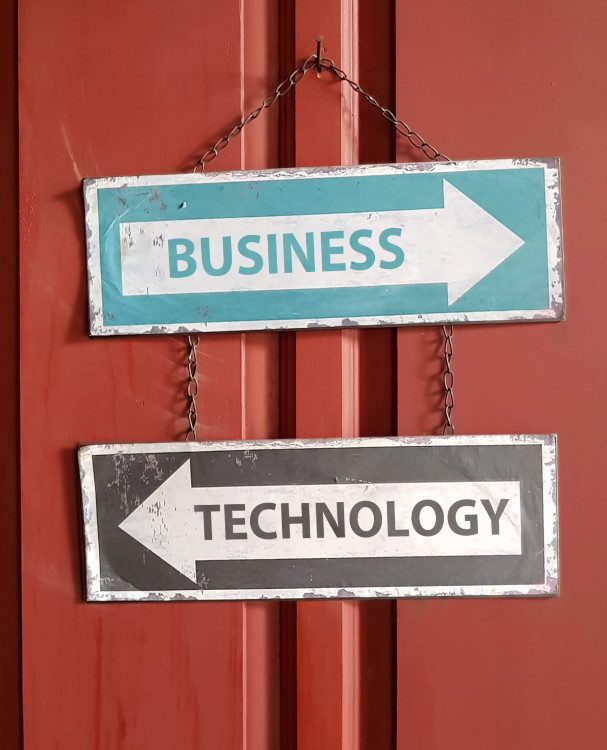

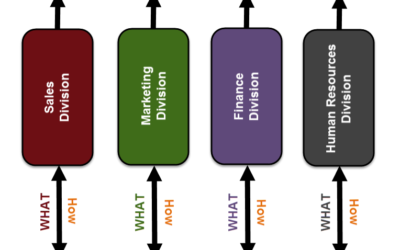
Muller
July 7, 2020Interesting strategy framework. It looks simple yet straight to the point. I like the “clear line of sight”. I will read up on it. Thank you for sharing
M
Virtual Tarzan
July 8, 2020Thank you for reading.
Nick
Thomas
July 9, 2020Good insight thank you. Can you clarify the type of metrics under measurement? How often do you track? I see in your example 12 month as measuring period?
Virtual Tarzan
July 11, 2020There are two types of metrics I would recommend using but were a bit too detailed to cover in a high-level post. leading and lagging metrics. The example used in the post showed the lagging metrics which measure the final result. Lagging indicators show the final result of your strategy which often could take several months or years to achieve. This presents a risk to the organisation as it may never discover that its strategy is not achieving the expected results for many months or years after the strategy started. Any needed adjustments will be late.
It is best to augment the lagging metrics with leading metrics. Leading metrics act as warning signs letting you know you are off course. However, they do not measure the final result.
Example of using both:
Lagging Metrics: Cross-selling and Up-Selling a will increase the average customer spend by an average of 10% in the first year and an average of 15% within 2 years.
Leading Metrics: cross-sell and up-sell 25% of existing customers within three months and 50% of customer will be sold within six months.
The short term metrics combined with the long term metrics are the best approach based on my experience.
Nick
Marco
July 12, 2020I read OGSM as ORGASM! 🙂
Ben Fatto
Virtual Tarzan
July 17, 2020Fascinating. I suggest a visit to Specsavers.
Nick
Bianca
July 15, 2020Can you please elaborate on your information gathering approach?
Thank you
Bianca
Virtual Tarzan
July 18, 2020Great question Bianca. I suggest using a SWOT Analysis (Strength, Weakness, Opportunity, and Threats) to gather information from each business division. By the end of the analysis, you are likely to end with tens if not hundreds of data points. Next, I suggest organising these data points into categories such as technology, security, products, services, etc. This will help identify common themes across the different business divisions. Next, I would score the top common categories based on how important they are to the executive leadership.
Nick
Bianca
July 20, 2020Thank you Nick for the detailed response.
Peter
July 17, 2020Are you with KPMG? you got my email I am interested to see if this framework is suitable for our needs
S.A
July 17, 2020It is a pity I did not see this post early in the year when I approved a strategy work by one of the big consultancy firms. After 3 hours and 100 page PowerPoint final presentation, I can say it was a disappointment. It was bloated, complicated and lacked clarity. This OGSM framework seems logical and easier to articulate to the business. My only concern is why would other division heads share their business details with me? IT does not get involved in the business side. I am just curious about how you tackled this.
Good post.
Virtual Tarzan
July 18, 20203 hours of PowerPoint presentation sounds like a torture session. OGSM can be presented (and should be) on one page.
I agree many business divisions will feel defensive about IT’s intrusion into their business. Yet logic is on your side. You are pushing the CEO’s mandate, which is to double revenue within 5 years as in our example. The CIO should articulate “I am planning next year IT strategy and I need to ensure it is aligned with the strategic business objectives. Understanding what each division is trying to achieve will help with that technology business alignment”.
Also, IT will use its expertise to map appropriate technology solutions to business challenges and goals identified.
Who is going to say no to someone trying to help and happens to be pushing the CEO’s mandate?
This is the approach I have found to be effective and persuasive.
Nick